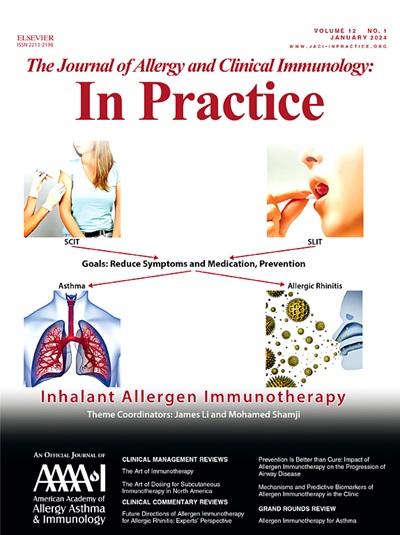美国原发性免疫缺陷疾病的人口统计报告
IF 6.6
1区 医学
Q1 ALLERGY
Journal of Allergy and Clinical Immunology-In Practice
Pub Date : 2025-09-01
DOI:10.1016/j.jaip.2025.06.015
引用次数: 0
摘要
原发性免疫缺陷疾病(PIDDs)是一种罕见的损害免疫力的遗传性疾病。评估美国历史边缘人群pidd诊断率的研究是有限的。目的进行范围审查,确定美国pidd患者观察性研究中种族和民族报告的程度,以及研究人群的人口组成与更广泛的美国人口的比较。方法我们于2024年4月对MEDLINE进行了语用检索,最终纳入了10年前的研究。结果由单一审稿人根据预先指定的资格标准进行筛选和提取。纳入的资料与美国人口普查资料采用χ2检验进行比较。我们确定了126篇发表观察性PIDD研究报告患者特征的出版物,其中62篇(49%)报告了种族或民族数据。为避免研究重叠,对数据源和PIDD类型进行分组后,优先抽取25篇文献。其中,七个完全符合当前食品和药物管理局推荐的报告指南。提取的研究人群在统计上不能代表更广泛的美国人口,非西班牙裔白人患者的代表性过高。根据目前美国食品和药物管理局的建议,原发性免疫缺陷疾病队列和其他研究报告的患者种族和民族人口统计数据不一致。努力提高对PIDD在不同美国人群中的患病率、特征和诊断率的理解(以及研究人群和美国总体人口统计数据之间的差异)可能会通过更全面的人口统计报告得到促进。本文章由计算机程序翻译,如有差异,请以英文原文为准。
Reported Demographics of Primary Immunodeficiency Diseases in the United States
Background
Primary immunodeficiency diseases (PIDDs) are rare genetic disorders impairing immunity. Studies evaluating diagnostic rates of PIDDs in historically marginalized US populations are limited.
Objective
To conduct a scoping review that identifies the extent of race and ethnicity reporting in US-based observational studies of people with PIDDs, and the demographic composition of study populations compared with the broader US population.
Methods
We conducted pragmatic searches of MEDLINE in April 2024 and ultimately included studies dating back 10 years. Results were screened and extracted against prespecified eligibility criteria by a single reviewer. Included data were compared with US census data using χ2 tests.
Results
We identified 126 publications publishing observational PIDD studies that report patient characteristics, 62 of which (49%) reported race or ethnicity data. After grouping for data source and PIDD type to avoid overlapping studies, 25 publications were prioritized for extraction. Of these, seven were fully compliant with current Food and Drug Administration–recommended reporting guidelines. The populations of the extracted studies were not statistically representative of the broader US population, with overrepresentation of non-Hispanic White patients.
Conclusions
Primary immunodeficiency disease cohort and other studies inconsistently report demographic data on patient race and ethnicity according to current Food and Drug Administration recommendations. Efforts to improve understanding of the prevalence, characteristics, and diagnostic rates of PIDD in different US populations (as well as differences among study populations and overall US demographics) would likely be facilitated by a greater effort toward comprehensive demographic reporting.
求助全文
通过发布文献求助,成功后即可免费获取论文全文。
去求助
来源期刊

Journal of Allergy and Clinical Immunology-In Practice
ALLERGYIMMUNOLOGY-IMMUNOLOGY
CiteScore
11.10
自引率
9.60%
发文量
683
审稿时长
50 days
期刊介绍:
JACI: In Practice is an official publication of the American Academy of Allergy, Asthma & Immunology (AAAAI). It is a companion title to The Journal of Allergy and Clinical Immunology, and it aims to provide timely clinical papers, case reports, and management recommendations to clinical allergists and other physicians dealing with allergic and immunologic diseases in their practice. The mission of JACI: In Practice is to offer valid and impactful information that supports evidence-based clinical decisions in the diagnosis and management of asthma, allergies, immunologic conditions, and related diseases.
This journal publishes articles on various conditions treated by allergist-immunologists, including food allergy, respiratory disorders (such as asthma, rhinitis, nasal polyps, sinusitis, cough, ABPA, and hypersensitivity pneumonitis), drug allergy, insect sting allergy, anaphylaxis, dermatologic disorders (such as atopic dermatitis, contact dermatitis, urticaria, angioedema, and HAE), immunodeficiency, autoinflammatory syndromes, eosinophilic disorders, and mast cell disorders.
The focus of the journal is on providing cutting-edge clinical information that practitioners can use in their everyday practice or to acquire new knowledge and skills for the benefit of their patients. However, mechanistic or translational studies without immediate or near future clinical relevance, as well as animal studies, are not within the scope of the journal.
 求助内容:
求助内容: 应助结果提醒方式:
应助结果提醒方式:


